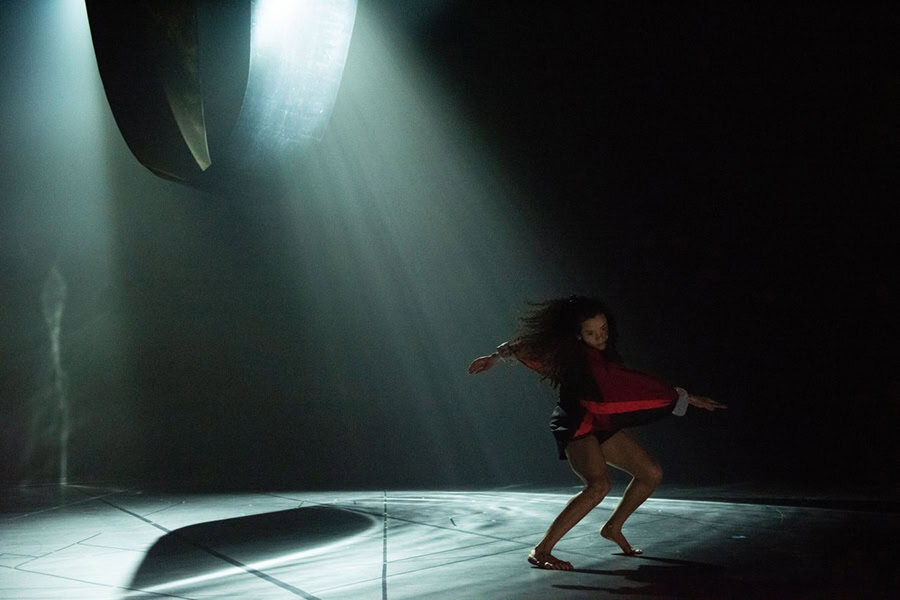Anne Teresa De Keersmaeker/Rosas, Mystery Sonatas/For Rosa at Sadler’s Wells
Posted: June 16th, 2022 | Author: Nicholas Minns | Filed under: Performance | Tags: Anne Teresa De Keersmaeker, Fauve Ryckebusch, Gli Incogniti, Heinrich Ignaz Franz Biber, Lynn Anderson, Minna Tiikkainen, Rafa Galdino | Comments Off on Anne Teresa De Keersmaeker/Rosas, Mystery Sonatas/For Rosa at Sadler’s WellsAnne Teresa de Keersmaeker/Rosas, Mystery Sonatas/ for Rosa, Sadler’s Wells, April 12, 2022
‘…If ever any beauty I did see, Which I desir’d, and got, t’was but a dreame of thee.’ John Donne, from The Good-Morrow

It takes someone of the sensibility and maturity of choreographer Anne Teresa De Keersmaeker to make a suite of dances from the Rosary Sonatas of Heinrich Ignaz Franz Biber. I had never heard them before seeing De Keersmaeker’s Mystery Sonatas/For Rosa at Sadler’s Wells, but they have since become essential listening. It is as if dance, in making music visible, allows it to enter the brain at double strength.
The Rosary Sonatas are a rigorous series of 15 short sonatas for violin and continuo Biber composed around 1676 to accompany the devotional rosary procession. Their performative structure is divided into three groups: five joyful, five sorrowful and five glorious sonatas, and they are crowned with a final passacaglia for solo violin, played in this performance in a recording by De Keersmaeker’s long-time collaborator, Amandine Beyer and Gli Incogniti. The sonatas’ spiritual purpose is co-mingled by Biber with bravura scordatura playing for the solo violin — Biber was a virtuoso of the instrument — that gives them an equally powerful physical and emotional dimension. By entering Biber’s sonatas through choreographic pathways, De Keersmaeker updates and refreshes his devotional music with subtle layers of cultural references that through the dancing body place it firmly within a humanistic tradition: a meditation on the strength and frailty of our senses, of our environment, of our being.
What makes theses sonatas a natural fit for choreographic treatment is that Biber wrote into them such popular dance forms as the gigue, allemande and courante. De Keersmaeker evidently finds in the fluent mathematical and musical elaboration of Baroque music the space in which to weave her own dance phrases; by the same token, Biber’s music possesses an inherent choreographic promise, which De Keersmaeker allows us to sense by playing one of the sonatas in full while the dancers lie still on stage. She is also confident enough to play a musical joke on Biber by interpolating a recording of Lynn Anderson singing, I Never Promised You a Rose Garden in an explosion of rose light, a bold yet subtle resonance that shocks while keeping on message.
At the very beginning, two dancers stand at the front of the stage, one whispering to the other a secret whose significance is marked by Minna Tiikainen’s flash of lightning. What follows is their secret that we view through the frame of the stage and through the bodies of the dancers: the essential nature of resistance along the spiritual path of exaltation, suffering and sublimation. As the brief program note states, ‘The dancing body, as an individual or a community, becomes an act of resistance, while Biber’s music, rich in virtuosity and narrative, opens a door to it.’ De Keersmaeker underlines the theme by dedicating the work ‘to women of resistance — Rosa Bonheur, Rosa Luxemburg, Rosa Parks, Rosa Vergaelen and Rosa, the 15-year-old climate activist who died in the Belgian floodings of 2021.’ As a corollary, one of the sonatas is a solo for Rafa Galdino costumed in the colours of Ukraine.
Tiikainen’s lighting dreams up a space that removes the theatre’s frame. Before the performance starts we can discern a strip of metal hanging in the darkness like the silver cowling of a jet engine. When light is reflected against this subtly turning or twisting Möbius-like strip, it creates a universe of light and shade that evokes, along with its atmospheric haze, the ethereal mysteries of a religious ritual. Fauve Ryckebusch’s costumes merge into Tiikainen’s light, softening the edges of the dancers with transparent material, and add to it by picking out colour highlights that give the stage the appearance of a borderless, pastel moving image.
The dancing is not virtuosic in technical terms, but it is superbly musical; this is the element that unites the performance. Instead of us watching the dancers moving, De Keersmaeker allows the music and the choreography to move us through the dancers. In a reverential gesture of reciprocity, De Keersmaeker in Mystery Sonatas/For Rosa opens a door to Biber’s music but turns it into the tide of her parallel conception of resistance. Throughout this extended meditation lies a reality beyond what we can see; a discursive dance traced in rose petal patterns that is at the same time a reminder of those mysteries that inform our humanity in the midst of a global existential crisis. Mystery Sonatas/For Rose is profoundly attuned to our time.